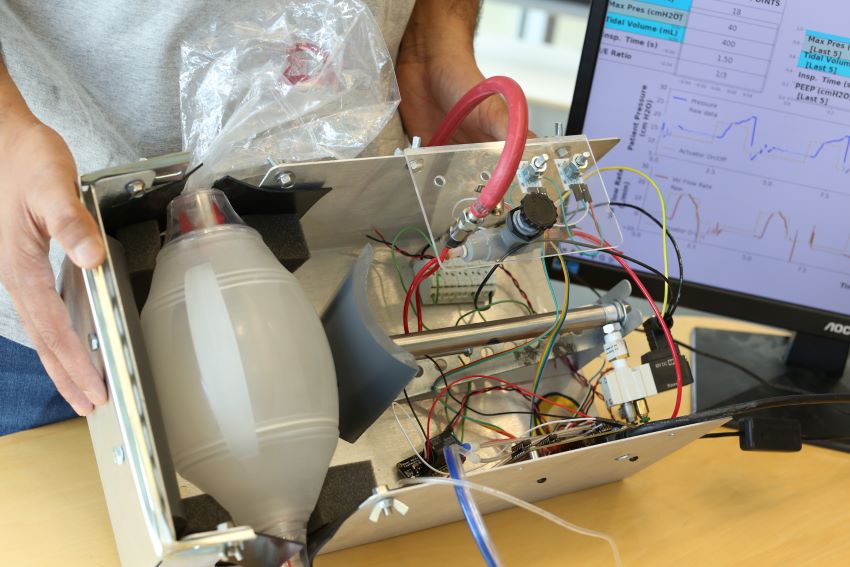BY NAVAMI NAIK*
The projected shortage of ventilators as a result of the COVID-19 pandemic has prompted an Indian American professor and his team at the Georgia Institute of Technology to create a prototype for a low-cost, portable emergency ventilator.
Devesh Ranjan, a professor and associate chair in Georgia Tech’s George W. Woodruff School of Mechanical Engineering and his research team evaluated what others had done and sought input on clinician needs from critical care specialists at two Atlanta hospitals.
The result was the Open-AirVentGT, designed to address acute respiratory distress syndrome (ARDS), a common complication for COVID-19 patients which causes their lungs to stiffen, requiring their breathing to be assisted by ventilators.
The ventilator is already generating interest from the global community. Dr. Ranjan was invited to present his invention at the World Economic Forum’s Global Lighthouse Network meeting last week. NRI Pulse spoke to Dr. Ranjan to understand more about the innovative ventilator and his plans for the invention.
1. Could you tell us a little more about your invention?
The global rise of COVID infection and the worrisome lack of adequate ventilators prompted our team to look into solutions. Our research revealed that clinicians who were treating COVID-19 patients needed more control over the system. The clinicians needed to be able to see what is happening with the patient’s respiration, and the ventilator needed to be able to respond to changing conditions. So, providing adequate control to clinicians became our primary objective while designing the ventilator.
Our Open-AirVentGT uses electronic sensors and computer control to manage key clinical parameters such as respiration rate, tidal volume (the amount of air moved into and out of the lungs during each cycle), inspiration and expiration ratio, and pressure on the lungs. The sensors and computer provide more control and real-time monitoring for doctors and other medical staff.
I cannot thank our team enough for transforming an idea into reality in just 3 weeks. This project was made possible by the dedication and long hours of hard work shown by students and staff at Georgia Tech while still maintaining social distancing.

2. What are some of the features that make your ventilator unique?
The uniqueness of the device is its patient assist mode, which makes breathing more natural, by allowing patients to trigger their own breaths instead of relying on a respiration rate pre-set in the device. The ventilator is designed to be produced for around $300. At this low cost, most of the make-shift ventilators do not offer this important feature.
Also, the Open-AirVentGT was designed to be fabricated from components available worldwide. That is why it uses the automation of an ambu-bag that is readily available in most healthcare settings. The pneumatic piston, which could be replaced by a different mechanical actuator, can be driven from a hospital compressed air supply, a portable compressor, or even a bottle of compressed air. The Raspberry Pi computer used in the prototype can be replaced with other computing sources, and the device is designed to adapt to different bag sizes.
3. Where and how do you envision your invention being used?
I am originally from Bihar in India, where more than 35 million people live below the poverty line. The medical infrastructure is poor and a majority of the population has little or no access to essential health care services. It is my personal desire to make a difference in that community.
With this in mind, the ventilator has been developed for use in countries that do not have adequate medical infrastructure in place. Our team is looking into the procedure for seeking FDA Emergency Use Authorization for the ventilator design and is reviewing how best to release the design so that others can mass-produce the ventilators to meet global needs. We have already been approached by Georgia Tech alumni in India and Ghana to set up manufacturing lines in their countries.
The demonstration of the prototype was also well received at the WEF Global Lighthouse Network meeting and they have invited me to share our design on their platform to promote visibility. This will ensure more manufactures with access to the supply chain and distribution line in African and Asian countries are able to build it as needed.
The Open-AirVentGT would be a good device to have in our national stockpile here in the United States so that it can be readily provided to areas in need.
In addition to Dr. Ranjan the multidisciplinary research team includes Gokul Pathikonda, a postdoctoral fellow in Dr. Ranjan’s lab who led the engineering development of the device, Stephen Johnston, Dan Fries, Cameron Ahmad, Benjamin Musci, Chang Hyeon Lim and Prasoon Suchandra, graduate students in the School of Mechanical Engineering; Kyle Azevedo, a research engineer with the Georgia Tech Research Institute; Prithayan Barua, a graduate student in the College of Computing working with Prof. Vivek Sarkar; Chris Ballance, a research engineer in the School of Aerospace Engineering; and Richard Bedell, Manager of Equipment Engineering and Support Services in the School of Chemistry and Biochemistry. They are also being assisted by Kyle French and Biye Wang at the Electronics Shop in the School of Mechanical Engineering.
*Navami Naik is an Atlanta-based public health and communications professional





